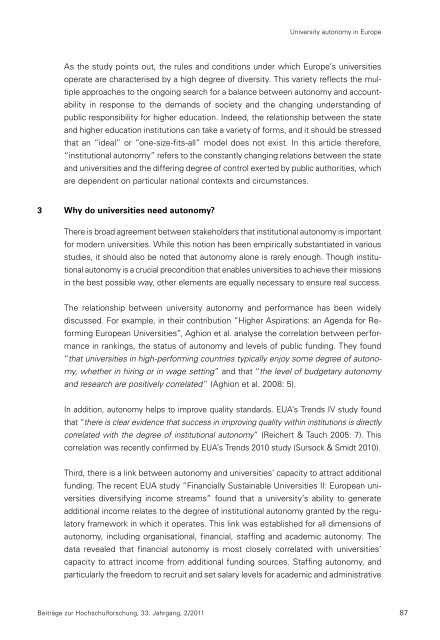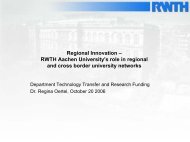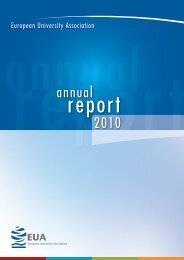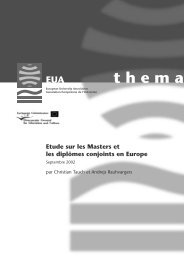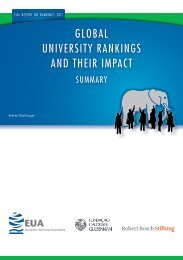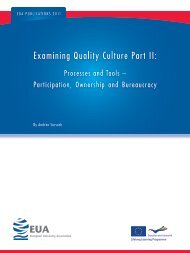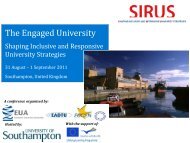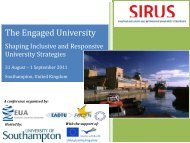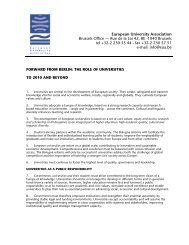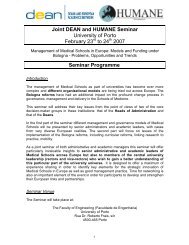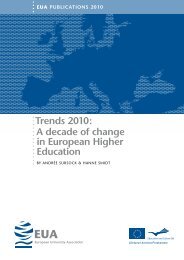Beiträge zur Hochschulforschung - European University Association
Beiträge zur Hochschulforschung - European University Association
Beiträge zur Hochschulforschung - European University Association
Create successful ePaper yourself
Turn your PDF publications into a flip-book with our unique Google optimized e-Paper software.
<strong>University</strong> autonomy in Europe<br />
As the study points out, the rules and conditions under which Europe’s universities<br />
operate are characterised by a high degree of diversity. This variety reflects the mul-<br />
tiple approaches to the ongoing search for a balance between autonomy and account-<br />
ability in response to the demands of society and the changing understanding of<br />
public responsibility for higher education. Indeed, the relationship between the state<br />
and higher education institutions can take a variety of forms, and it should be stressed<br />
that an “ideal” or “one-size-fits-all” model does not exist. In this article therefore,<br />
“institutional autonomy” refers to the constantly changing relations between the state<br />
and universities and the differing degree of control exerted by public authorities, which<br />
are dependent on particular national contexts and circumstances.<br />
3 Why do universities need autonomy?<br />
There is broad agreement between stakeholders that institutional autonomy is important<br />
for modern universities. While this notion has been empirically substantiated in various<br />
studies, it should also be noted that autonomy alone is rarely enough. Though institu-<br />
tional autonomy is a crucial precondition that enables universities to achieve their missions<br />
in the best possible way, other elements are equally necessary to ensure real success.<br />
The relationship between university autonomy and performance has been widely<br />
discussed. For example, in their contribution “Higher Aspirations: an Agenda for Re-<br />
forming <strong>European</strong> Universities”, Aghion et al. analyse the correlation between perfor-<br />
mance in rankings, the status of autonomy and levels of public funding. They found<br />
“that universities in high-performing countries typically enjoy some degree of autono-<br />
my, whether in hiring or in wage setting” and that “the level of budgetary autonomy<br />
and research are positively correlated” (Aghion et al. 2008: 5).<br />
In addition, autonomy helps to improve quality standards. EUA’s Trends IV study found<br />
that “there is clear evidence that success in improving quality within institutions is directly<br />
correlated with the degree of institutional autonomy” (Reichert & Tauch 2005: 7). This<br />
correlation was recently confirmed by EUA’s Trends 2010 study (Sursock & Smidt 2010).<br />
Third, there is a link between autonomy and universities’ capacity to attract additional<br />
funding. The recent EUA study “Financially Sustainable Universities II: <strong>European</strong> uni-<br />
versities diversifying income streams” found that a university’s ability to generate<br />
additional income relates to the degree of institutional autonomy granted by the regu-<br />
latory framework in which it operates. This link was established for all dimensions of<br />
autonomy, including organisational, financial, staffing and academic autonomy. The<br />
data revealed that financial autonomy is most closely correlated with universities’<br />
capacity to attract income from additional funding sources. Staffing autonomy, and<br />
particularly the freedom to recruit and set salary levels for academic and administrative<br />
<strong>Beiträge</strong> <strong>zur</strong> <strong>Hochschulforschung</strong>, 33. Jahrgang, 2/2011 87


